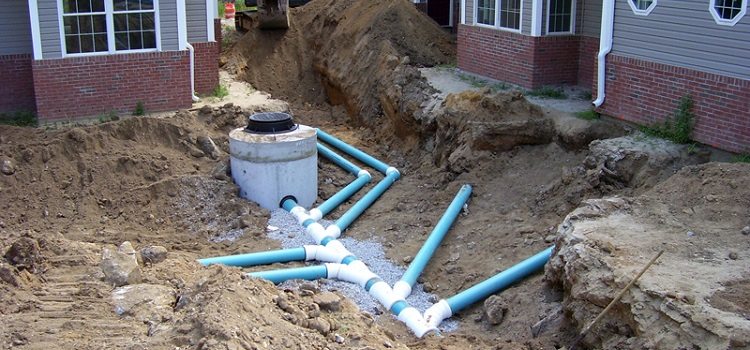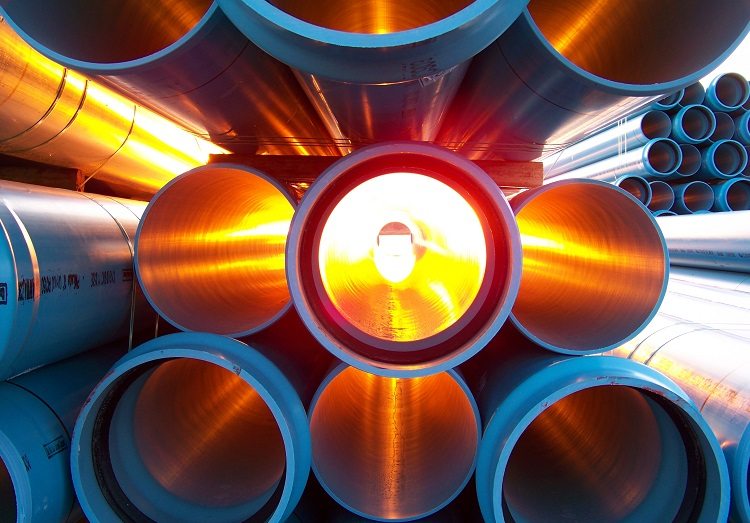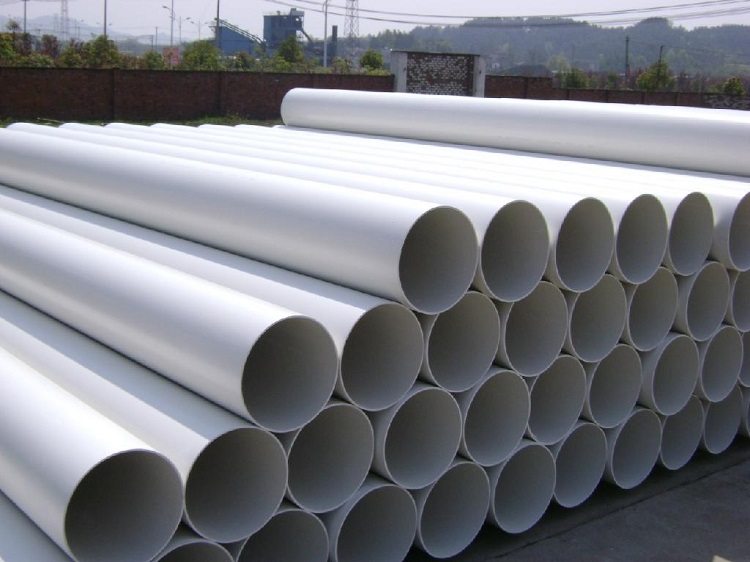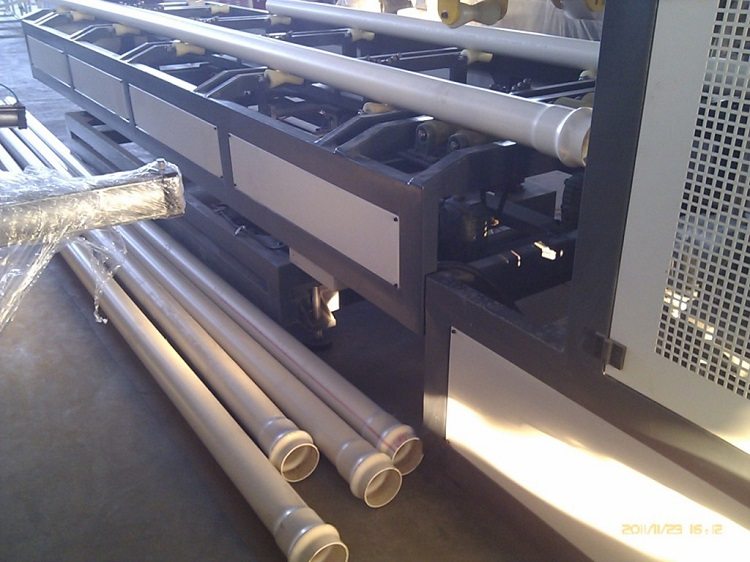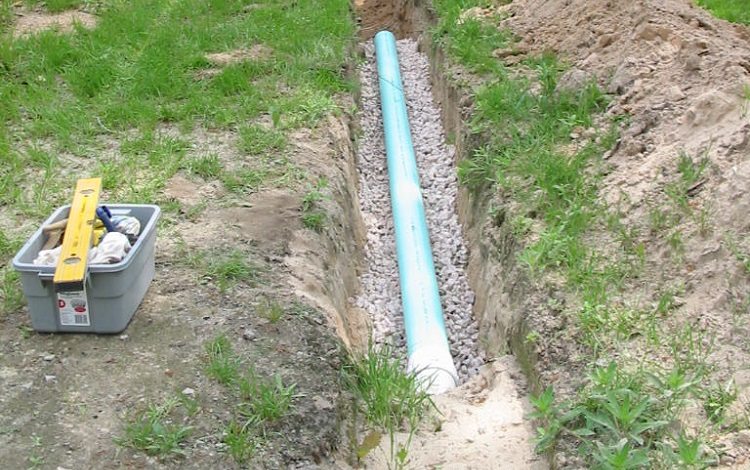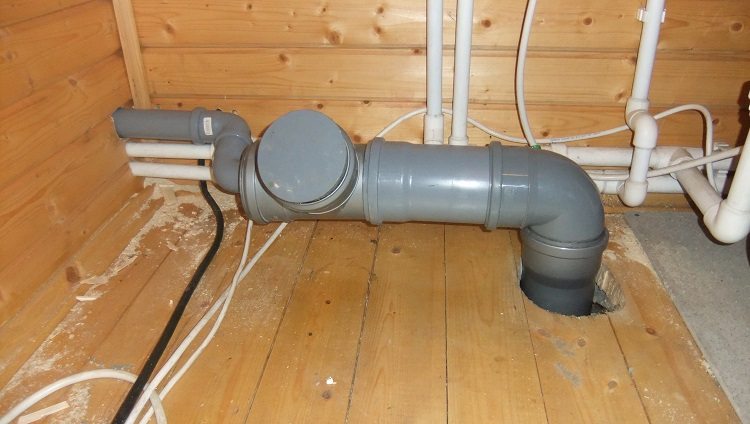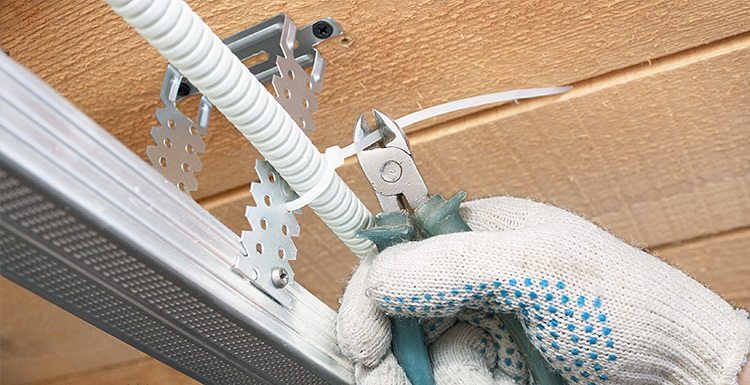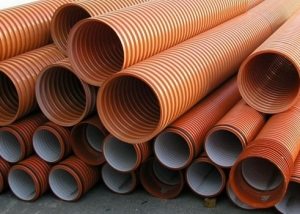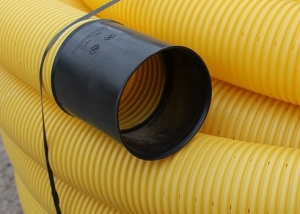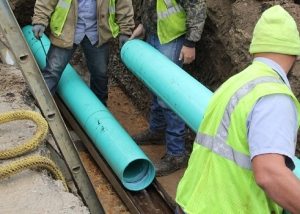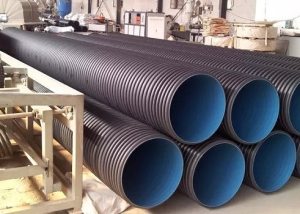Polyvinyl chloride (or simply PVC) pipes are the most suitable option for arranging a variety of systems: external or internal sewerage, wiring, etc. This is due to their durability, corrosion and stray currents, resistance to organic and chemical substances, smooth surface inside. On PVC products there are a number of documents regulating their parameters: GOST 51613, 1898 and 52134, adopted from 2000 to 2003.
Content
- 1 Overview of GOST PVC pipes
- 2 Some provisions of GOST 18599
- 3 Types and sizes of products according to GOST 51613
- 4 Sizes of bells in accordance with GOST 51613
- 5 Requirements for PVC products according to 51613-2000
- 6 Parameters of pipes for sewerage and water supply in accordance with GOST 52134
- 7 52134 limit deviations
- 8 Designation of pipes and fittings according to GOST 52134
- 9 PVC pipe safety requirements
- 10 Advantages of PVC sewer pipes
- 11 Installation of an external sewage network
- 12 PVC internal drainage
- 13 Corrugated Electrical PVC Pipes
- 14 Parameters of PVC Corrugated Pipe
- 15 Elements for mounting wiring with PVC pipes
- 16 Installation of PVC corrugated pipes
Overview of GOST PVC pipes
Document 51613 of 2000 extends to pressure products made from unplasticized PVC. They can be used for plumbing, transporting drinking water, the temperature of which is 0-45 ºС, and other liquids, as well as gaseous substances.
Depending on the temperature of the medium, a pressure reduction coefficient is selected: 41-45 ºС - 0.64; 36-40 ºС - 0.70; 31-35 ºС - 0.78; 26-30 ºС - 0.88; up to 25 ºС - 1.00.
Note! GOST does not apply to electrical pipes.
Document 52134 of 2003 includes dimensions and requirements for fittings and pressure pipes from various thermoplastics, including unplasticized and chlorinated PVC. GOST 18599-2001 pipe made according to standard 52134 does not contradict. Such products can be used not only for water supply, but also for heating.
There are separate regulatory documents for PVC pipes for outdoor sewage. GOST 32413 of 2013 regulates the parameters of just such products and shaped elements for them.
Some provisions of GOST 18599
The main characteristics of polyethylene pressure pipes are defined in GOST 1898-2001. PVC sewer pipes also belong to thermoplastics products.
Standard 18599 contains guidelines for the use of pressure pipes made of polyethylene, their main dimensions, parameters, designation and labeling, technical requirements, test conditions and acceptance rules.
Plastic pipes are made of materials PE 63, PE 100, PE 32, PE 80. For each type, the dimensions and marginal deviations of linear parameters are defined in document 18599. The value of the parameter for reducing the working pressure (maximum) at the temperature of the water that is transported through the pipeline to 40 ºС is given in the table.
Table 1
| Water temperature | Pressure reduction coefficient, * 10-1 | ||
| PE (PE) 32 | PE (PE) 63 | PE (PE) 80 and PE (PE) 100 | |
| Up to 20 | 10,0 | 10,0 | 10,0 |
| 26-30 | 8,2 | 9,0 | 9,3 |
| 21-25 | 6,5 | 8,1 | 8,7 |
| 31-35 | 4,7 | 7,2 | 8,0 |
| 36-40 | 3,0 | 6,2 | 7,4 |
GOST 18599 allows the manufacture of technical pipes from recycled materials.
Types and sizes of products according to GOST 51613
According to GOST 51613-2000 PVC pipes are made of the following types:
- with a bell for adhesive bonding (PK);
- without a bell;
- with a bell for connection with a sealing ring having a special section (P).
Pipe sizes according to 51613-2000 are presented in tables 1 and 2 (SDR / S / MOP, respectively, size ratio / series / maximum value of working pressure in MPa).
table 2
| Outer Diameter * 102mm | Wall thickness for the pipe NPVH 100, * 10-1 mm | |||||
| SDR / S / MOP:
41/20/0,5 |
SDR / S / MOP:
33/16/0,63 |
SDR / S / MOP:
26/12,5/0,8 |
SDR / S / MOP:
21/10/1,0 |
SDR / S / MOP:
17/8/1,25 |
SDR / S / MOP:
13,6/6,3/1,6 |
|
| 0,1 | — | — | — | — | — | 15 |
| 0,12 | — | — | — | — | — | 15 |
| 0,16 | — | — | — | — | — | 15 |
| 0,20 | — | — | — | — | — | 15 |
| 0,25 | — | — | — | — | 15 | 19 |
| 0,32 | — | — | — | 16 | 19 | 24 |
| 0,40 | — | 15 | 16 | 19 | 24 | 30 |
| 0,50 | — | 16 | 20 | 24 | 30 | 37 |
| 0,63 | 16 | 20 | 25 | 30 | 38 | 47 |
| 0,75 | 19 | 23 | 29 | 36 | 45 | 56 |
| 0,90 | 22 | 28 | 35 | 43 | 54 | 67 |
Table 3
| Outer Diameter * 102 mm | Wall thickness for the pipe NPVH 125 (100), * 10-1 mm | |||||
| SDR / S / MOP:
41/20/0,63(0,5) |
SDR / S / MOP:
33/16/0,8(0,63) |
SDR / S / MOP:
26/12,5/1,0(0,8) |
SDR / S / MOP:
21/10/1,25(1,0) |
SDR / S / MO:
17/8/1,6(1,25) |
SDR / S / MOP:
13,6/6,3/2,0(1,6) |
|
| 1,10 | 27 | 34 | 42 | 53 | 66 | 81 |
| 1,25 | 31 | 39 | 48 | 60 | 74 | 92 |
| 1,40 | 35 | 43 | 54 | 67 | 83 | 103 |
| 1,60 | 40 | 49 | 62 | 77 | 95 | 118 |
| 1,80 | 44 | 55 | 69 | 86 | 107 | 133 |
| 2,00 | 49 | 62 | 77 | 96 | 119 | 147 |
| 2,25 | 55 | 69 | 86 | 108 | 134 | 166 |
| 2,50 | 62 | 77 | 96 | 119 | 148 | 184 |
| 2,80 | 69 | 86 | 107 | 134 | 166 | 206 |
| 3,15 | 77 | 97 | 121 | 150 | 187 | 232 |
Sizes of bells in accordance with GOST 51613
The bells for the o-ring for the connection must have the dimensions shown in the table, where a1 is the internal diameter of the socket (* 10-1 mm), a2 is the internal diameter of the socket at the place of installation of the ring (* 10-1 mm), e1 is the wall thickness of the socket (* 10-1 mm), g1 is the length of the socket to the groove under the ring (mm), g is the length of the socket (* 10-1 mm), a is the angle of the chamfer, SDR / S, respectively, the dimension ratio / series.
Table 4
| Nominal outer diameter *102 mm |
a1 | a2 | e1 at SDR / S | g1 | g | AND | |||||
| 41/20 | 33/16 | 26/12,5 | 21/10 | 17/8 | 13,6/6,3 | ||||||
| 0,63 | 636 | 800 | — | — | — | — | 42 | 52 | 13 | 995 | 6 |
| 0,75 | 756 | 939 | — | — | — | 40 | 50 | 62 | 14 | 1025 | 7 |
| 0,90 | 907 | 1107 | — | — | 39 | 47 | 59 | 74 | 15 | 1105 | 8 |
| 1,10 | 1108 | 1325 | — | 37 | 46 | 58 | 73 | 89 | 17 | 1160 | 10 |
| 1,25 | 1259 | 1484 | — | 43 | 53 | 66 | 81 | 101 | 19 | 1215 | 11 |
| 1,40 | 1409 | 1642 | 39 | 47 | 59 | 74 | 91 | 113 | 20 | 1270 | 12 |
| 1,60 | 1610 | 1860 | 44 | 54 | 68 | 85 | 105 | 130 | 22 | 1345 | 14 |
| 1,80 | 1811 | 2083 | 48 | 61 | 76 | 95 | 118 | 146 | 23 | 1405 | 16 |
| 2,00 | 2012 | 2289 | 54 | 68 | 85 | 106 | 131 | 162 | 25 | 1465 | 18 |
| 2,25 | 2264 | 2545 | 61 | 76 | 95 | 119 | 147 | 183 | 27 | 1540 | 20 |
| 2,50 | 2515 | 2819 | 68 | 85 | 106 | 131 | 163 | 202 | 29 | 1622 | 22 |
| 2,80 | 2816 | 3147 | 76 | 95 | 118 | 147 | 183 | 227 | 32 | 1720 | 24 |
| 3,15 | 3168 | 3513 | 85 | 107 | 133 | 165 | 206 | 225 | 35 | 1840 | 26 |
Sockets for adhesive bonding according to 51613-2000 must correspond to the parameters in the table, where a1 is the internal diameter of the socket (* 10-1 mm), g is the length of the socket (cm), a is the angle of the chamfer.
Table 5
| External diameter, *102 mm |
g | a1 | and |
| 0,10 | 2,8 | 103 | 2 |
| 0,12 | 2,8 | 123 | 2 |
| 0,16 | 2,8 | 163 | 2 |
| 0,20 | 3,2 | 203 | 3 |
| 0,25 | 3,2 | 253 | 3 |
| 0,32 | 3,2 | 323 | 3 |
| 0,40 | 4,0 | 403 | 4 |
| 0,50 | 5,0 | 503 | 5 |
| 0,63 | 6,3 | 633 | 6 |
| 0,75 | 7,0 | 753 | 7 |
| 0,90 | 7,9 | 903 | 8 |
| 1,10 | 9,1 | 1103 | 10 |
| 1,25 | 10,0 | 1253 | 11 |
| 1,40 | 10,9 | 1404 | 12 |
| 1,60 | 12,1 | 1604 | 14 |
Requirements for PVC products according to 51613-2000
The basis for the manufacture of PVC pipes (GOST 14040) is suspension polyvinyl chloride having a K value of not less than 67.
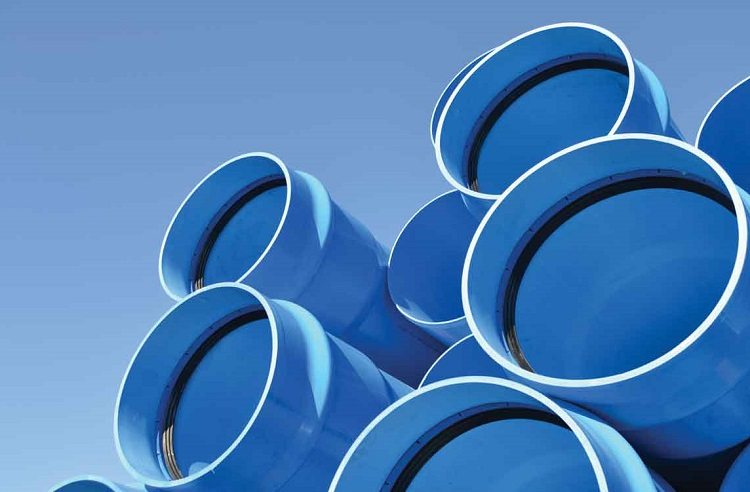
Both the inner and outer surfaces of the pipes must be smooth; an o-ring is mandatory inside the socket
The surfaces inside and outside should be smooth with acceptable slight undulation and longitudinal stripes. The standard defines strength indicators at constant pressure inside the pipe. The corresponding values are given in the table.
Table 6
| Temperature, ºС | Initial voltage * 10 MPa |
Resistance, h, not less |
| 20 | 4,2 | 1 |
| 20 | 3,5 | 100 |
| 60 (for PVC (1) 100) | 1,0 | 1 thousand |
| 60 (for PVC (1) 125) | 1,25 | 1 thousand |
In GOST 51613-2000 for PVC sewage pipes (pressure pipes), the value of Charpy impact strength is determined. It is important that the number of collapsed samples is not more than 10%.
Note! After heating, the permissible change in length is not more than 5 percent.
Some other parameters of pipes that can be used for external as well as internal sewerage are given in the table.
Table 7
| Index | Value | unit of measurement |
| The yield strength during tension for products with a diameter of more than 0.12 * 102 mm | 49*103 | not less than kPa |
| Elongation at break for products with a diameter of more than 0.12 * 102 mm | 25 | % |
| By Wick softening point | 78 | not less ºС |
| Opacity | 0,2 | not more, % |
Parameters of pipes for sewerage and water supply in accordance with GOST 52134
In accordance with GOST 52134-2003 pipes have dimensions depending on the series and SDR of the product. They are available in straight segments.
The estimated mass must comply with the values in GOST 51613 and 18599.
Table 8
| External diameter, *102 mm |
Estimated mass of a meter of a pipe at SDR / S, * 10-1 kg | |||||
| 41/20 | 33/16 | 26/12,5 | 21/10 | 17/8 | 13,6/6,3 | |
| 0,1 | — | — | — | — | — | 0,63 |
| 0,12 | — | — | — | — | — | 0,78 |
| 0,16 | — | — | — | — | — | 1,08 |
| 0,20 | — | — | — | — | — | 1,38 |
| 0,25 | — | — | — | — | 1,75 | 2,13 |
| 0,32 | — | — | — | 2,40 | 2,78 | 3,44 |
| 0,40 | — | 2,87 | 3,04 | 3,51 | 4,37 | 5,35 |
| 0,50 | — | 3,83 | 4,74 | 5,54 | 6,80 | 8,12 |
| 0,63 | 4,86 | 6,03 | 7,31 | 8,69 | 10,6 | 12,9 |
| 0,75 | 6,75 | 8,14 | 9,98 | 12,2 | 15,0 | 18,2 |
| 0,90 | 9,45 | 11,7 | 14,4 | 17,5 | 21,5 | 26,1 |
| 1,10 | 13,9 | 17,3 | 21,1 | 26,2 | 32,0 | 38,6 |
| 1,25 | 18,2 | 22,3 | 27,2 | 33,4 | 40,8 | 49,7 |
| 1,40 | 22,8 | 27,7 | 34,3 | 41,9 | 51,1 | 62,3 |
| 1,60 | 29,8 | 35,8 | 44,9 | 54,8 | 66,7 | 81,2 |
| 1,80 | 36,7 | 45,3 | 55,9 | 68,9 | 84,3 | 103 |
| 2,00 | 45,0 | 56,6 | 69,3 | 85,3 | 104 | 126 |
| 2,25 | 57,0 | 70,5 | 87,0 | 108 | 132 | 160 |
| 2,50 | 71,3 | 87,4 | 108 | 132 | 162 | 198 |
| 2,80 | 88,3 | 109 | 134 | 166 | 203 | 247 |
| 3,15 | 111 | 138 | 171 | 209 | 257 | 314 |
At the same time, the density of material equal to 1400 kg / m is taken in GOST. The mass of type P sockets is given in the table.
Table 9
| External diameter, *102 mm |
Estimated mass of sockets at SDR / S, * 10-1kg | |||||
| 41/20 | 33/16 | 26/12,5 | 21/10 | 17/8 | 13,6/6,3 | |
| 0,63 | — | — | — | — | 1,40 | 1,71 |
| 0,75 | — | — | — | 1,63 | 2,01 | 2,46 |
| 0,90 | — | — | 2,03 | 2,43 | 3,02 | 3,73 |
| 1,10 | — | 2,44 | 3,01 | 2,69 | 4,68 | 5,63 |
| 1,25 | — | 3,32 | 4,06 | 5,01 | 6,09 | 7,48 |
| 1,40 | 3,50 | 4,20 | 5,23 | 6,43 | 7,91 | 9,68 |
| 1,60 | 4,74 | 5,78 | 7,22 | 8,95 | 10,9 | 13,3 |
| 1,80 | 6,05 | 7,64 | 9,45 | 11,7 | 14,4 | 17,5 |
| 2,00 | 7,79 | 9,75 | 12,1 | 14,9 | 18,3 | 22,2 |
| 2,25 | 10,3 | 12,7 | 15,8 | 19,6 | 23,9 | 29,3 |
| 2,50 | 13,4 | 16,6 | 20,6 | 25,2 | 30,9 | 37,8 |
| 2,80 | 17,7 | 22,0 | 27,1 | 33,4 | 41,1 | 50,2 |
| 3,15 | 23,6 | 29,5 | 36,4 | 44,8 | 55,2 | 67,4 |
52134 limit deviations
The normative document, referring to GOST 18599-2001, for PVC sewer pipes determines such limit deviations in diameter and permissible ovality.
Table 10
| Outside diameter *102 mm |
PVC unplasticized | PVC chlorinated | ||
| Ovality, * 10--1mm | Maximum deviation (+), * 10-1 mm | Ovality, * 10-1 mm | Maximum deviation (+), * 10-1 mm | |
| 0,1 | — | — | 12 | 2 |
| 0,12 | 12 | 3 | 12 | 3 |
| 0,16 | 12 | 3 | 12 | 3 |
| 0,20 | 12 | 3 | 12 | 3 |
| 0,25 | 12 | 3 | 12 | 3 |
| 0,32 | 13 | 3 | 13 | 3 |
| 0,40 | 14 | 3 | 14 | 3 |
| 0,50 | 14 | 3 | 14 | 3 |
| 0,63 | 15 | 3 | 15 | 3 |
| 0,75 | 16 | 3 | 16 | 3 |
| 0,90 | 18 | 3 | 18 | 3 |
| 1,10 | 22 | 4 | 22 | 4 |
| 1,25 | 25 | 4 | 25 | 4 |
| 1,40 | 28 | 5 | 28 | 5 |
| 1,60 | 32 | 5 | 32 | 5 |
| 1,80 | 36 | 6 | 36 | 6 |
| 2,00 | 40 | 6 | 40 | 6 |
| 2,25 | 45 | 7 | 45 | 7 |
| 2,50 | 50 | 8 | 50 | 8 |
| 2,80 | 68 | 9 | 68 | 9 |
| 3,15 | 76 | 10 | 76 | 10 |
| 3,55 | 86 | 11 | 86 | 11 |
| 4,00 | 96 | 12 | 96 | 12 |
| 4,50 | 108 | 14 | 108 | 14 |
| 5,00 | 120 | 15 | 120 | 15 |
| 5,60 | 135 | 17 | 135 | 17 |
| 6,30 | 152 | 19 | 152 | 19 |
| 7,10 | 171 | 20 | — | — |
| 8,00 | 192 | 20 | — | — |
| 9,00 | 216 | 20 | — | — |
| 10,00 | 240 | 20 | — | — |
Also, GOST 52134 gives the permissible deviations that may be at the pipe wall thicknesses. Values are given in the table.
Table 11
| Pipe wall thickness range, *10-1mm |
Maximum deviation, * 10-1 mm | |
| PVC unplasticized | PVC chlorinated | |
| 10-20 | 4 | 4 |
| 21-30 | 5 | 5 |
| 31-40 | 6 | 6 |
| 41-50 | 7 | 7 |
| 51-60 | 8 | 8 |
| 61-70 | 9 | 9 |
| 71-80 | 10 | 10 |
| 81-90 | 11 | 11 |
| 91-100 | 12 | 12 |
| 101-110 | 13 | 13 |
| 111-120 | 14 | 14 |
| 121-130 | 15 | 15 |
| 131-140 | 16 | 16 |
| 141-150 | 17 | 17 |
| 151-160 | 18 | 18 |
| 161-170 | 19 | 19 |
| 171-180 | 20 | 20 |
| 181-190 | 21 | 21 |
| 191-200 | 22 | 22 |
| 201-210 | 23 | 23 |
| 211-220 | 24 | 24 |
| 221-230 | 25 | 25 |
| 231-240 | 26 | 26 |
| 241-250 | 27 | 27 |
| 251-260 | 28 | 28 |
| 261-270 | 29 | 29 |
| 271-280 | 30 | 30 |
| 281-290 | 31 | 31 |
| 291-300 | 32 | 32 |
| 301-310 | 33 | — |
| 311-320 | 34 | — |
| 321-330 | 35 | — |
| 331-340 | 36 | — |
| 341-350 | 37 | — |
| 351-360 | 38 | — |
| 361-370 | 39 | — |
| 371-380 | 40 | — |
Designation of pipes and fittings according to GOST 52134
All regulatory documents (GOST 51613, 52134, 18599) provide the rules for the symbol of the pipe.It usually includes the abbreviated name of PVC (NPVH 125 or NPVH 100), type of bell, size ratio.
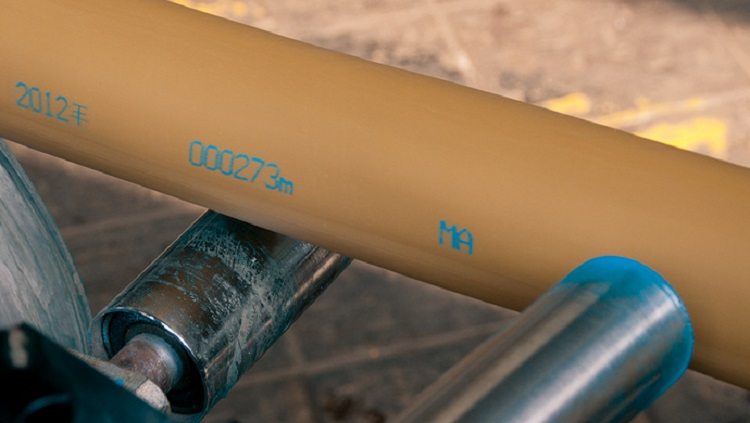
Any type of pipe must be marked in accordance with the requirements of the standards, this data informs the buyer about the technical characteristics of the products
Also, dashes show the numerical values of the wall thickness and the outer diameter. In addition, the pipe has a designation of its purpose:
- household drinking;
- technical.
The designation of fittings from a variety of thermoplastics includes the name of the material of production, the value of the minimum long-term strength increased by 10 times, the size ratio. The dash indicates the nominal diameter (outer) of the pipe and its wall thickness, which will be connected, the class of operation, the nominal pressure, expressed in MPa.
At the end of the product designation is given GOST, according to which they are made.
PVC pipe safety requirements
Pipes made of unplasticized PVC can be assigned to the third hazard class defined in GOST 12.1.005, as well as to the group of slow-burning products (GOST 12.1.044), the ignition temperature of which is not lower than 300 degrees.
During storage and use, such pipes are not able to release toxic substances into the environment. Contact with them does not require the use of personal protective equipment. The safety of the production process must meet the requirements of GOST 12.3.030.
Note! Sanitary standards allow the release of vinyl chloride in water not more than 0.01 mg / l during operation by household drinking pipes from unplasticized PVC.
To prevent atmospheric pollution during production, the requirements of GOST 17.2.3.02 must be met. Before putting into operation pipelines for household and drinking purposes, they are washed with drinking water for more than 2 hours.
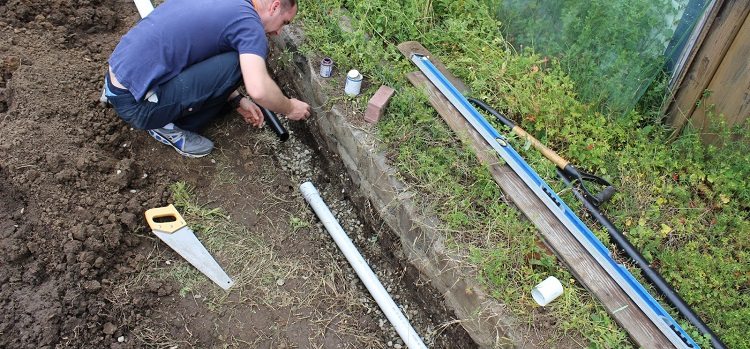
PVC pipes are also used to supply drinking water, in which case the new pipeline must be flushed after installation
Advantages of PVC sewer pipes
GOSTs regulate the basic parameters and characteristics of PVC products. Such communications are the most acceptable option for arranging an external sewer network, since they can last up to half a century at a temperature of no more than 45 ºС. They also have high hygiene and environmental friendliness.
Light weight and a variety of fittings provide convenient transportation and quick installation. The external sewage system is possible due to the resistance of the pipe to ultraviolet radiation, low temperatures and its low combustibility.
When choosing a suitable PVC product, you should pay attention to such parameters as diameters, length and strength class. In addition, it is important to be sure that you comply with GOST PVC pipes for sewage.
There are three groups of stiffness:
- Heavy (S) withstanding 8 thousand N / m2;
- Average (N), withstanding 4 thousand N / m2;
- Light (L), withstanding 2 thousand N / m2.
The first class is designated SN-8 and has the possibility of underground laying up to 8 m deep, the second - SN-4 - under areas with low traffic, the third - SN-2 can be located at a shallow depth.
Installation of an external sewage network
PVC pipes, GOSTs on which their parameters are determined, can be used in internal and external sewage networks. For the second option, products according to documents 51613-2000 and 52134 from 2003, equipped with a sealing ring and a bell, are suitable.
The laying of PVC pipes of the external network starts from the foundation. The place of entry of the part into the bell is lubricated, and it is inserted into it until it stops. The pipeline is insulated with a special heat-insulating material.
Note! When laying, a slope of 0.02 m per meter of the length of the PVC pipe is observed.
Revision wells are mounted every 15 meters.At the final stages, the slope of the system is checked and it is sprinkled in layers by sand, which is slightly compacted on the sides. Next, the trench is filled with soil. The entire sewage pipeline is laid to a septic tank or sewage well.
PVC internal drainage
The internal sewer system is designed to remove wastewater from residential premises and buildings. It consists of pipes, branch lines, outlets and risers. For this reason, installation work is carried out at the construction stage.
Such sewage system is used for continuous or short-term operation. During installation, bonding and socket connection are used. Mounting clamps prevent slipping during installation. It is necessary to observe such distances when fixing the elements:
- one or two meters for vertical lines;
- 10 diameters of communications for horizontal sections;
- between sewer pipes and walls - at least 4 mm.
The use of two turns of 45 degrees rather than one of 90 turns will help to reduce the noise level. It is also important to prevent burrs at the ends of the products after cutting, since the presence of roughness and protrusions contributes to the accumulation of unwanted deposits in such places and the formation of blockages.
Corrugated Electrical PVC Pipes
Key documents for PVC pipe for electrical wiring - GOSTs. Such products are manufactured according to GOST 51613, their installation is determined by GOST 30244.
Note! Corrugated products are intended for laying electrical wiring in floors, ceilings, walls and in open form in storage and industrial premises.
Structurally, such communications have 2 layers - external corrugated and internal - extremely smooth. Due to such a structure, they have significant ring stiffness, a good degree of protection during thermal or mechanical impacts, and increased flexibility.
Reinforced corrugated products are made of a spiral frame, which is filled with soft polyvinyl chloride. They are most often used to connect control panels to power panels and to combine process equipment operating with increased vibrations.
Parameters of PVC Corrugated Pipe
GOST 14254 regulates the degree of protection that electrical pipes must provide. Corrugated PVC products meet all the requirements of this document. They are made of a material characterized by self-extinguishing ability.
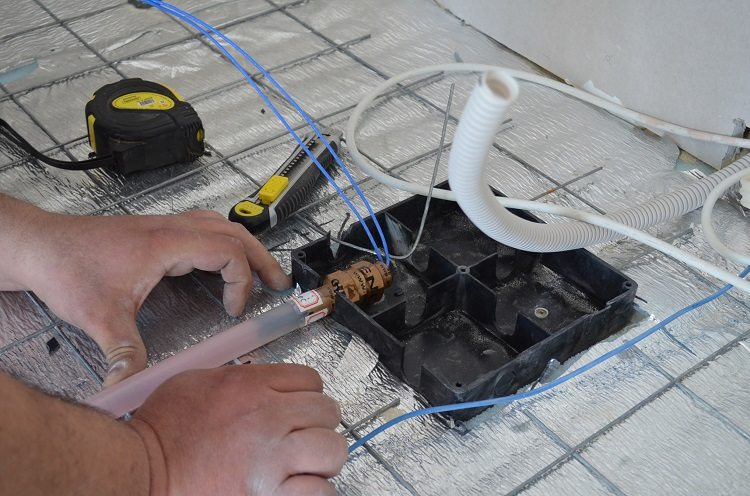
PVC corrugations are often used to lay electrical wiring in an open way and protect it from pressure during flush mounting
Installation can be carried out at temperatures of -5 - +60 degrees. To facilitate the placement of the wiring cable inside the pipe, the latter can be equipped with a broach. Heavy products have increased strength and can be laid under a cement screed. Corrugated pipes are packed in bays of 100, 50, 25, 20 and 15 meters, which can be stored for up to two years.
Such products make it possible to mount the system in a space with limited volume, which does not allow the use of boxes and rigid parts, and are also able to withstand voltages of up to 1 kV.
Various documents for electrotechnical corrugated polyvinyl chloride pipes (GOSTs, TU) determine their diameters (0.16-0.63 (* 102 ) mm), color (white or gray) and marking (T - heavy, L - light, 1 - with broach, 0 - without broach).
Elements for mounting wiring with PVC pipes
GOSTs determine the characteristics of products, the diversity of which allows for quality installation. Rigid and corrugated PVC tubes are installed using many non-combustible elements. These include:
- coupling (for joining pipes inside or outside rooms with high humidity);
- elbow or elbow (for joining parts at right angles);
- box (to ensure connection with junction boxes);
- tee (to provide a T-shaped union of rigid elements);
- fastenings with a collar (for installation of tubes on a wall);
- corrugated sleeve (either gray or transparent);
- latch holders.
The use of all these additional elements ensures high tightness of the system. If the tube is equipped with a broach, then it is necessary to have a bite during cutting.
Note! It is important to monitor the wire (broach) so that it does not slip into the pipe.
When installing a harness consisting of several wires, they must be fastened and connected to the broach end. When choosing a suitable corrugated product, it is important to precisely determine the diameter and take into account that the catalogs give the external value of this parameter for the pipe.
Installation of PVC corrugated pipes
GOSTs and other regulatory documents govern not only the characteristics and features of products, but also the rules for their use. When installing electrical wiring, it is important that all requirements are met.
The initial stage of work is to draw up a wiring diagram that would preclude pipe crossing, and marking. If you want to ensure only mechanical protection of the wires, you can limit yourself to installing an unpressurized pipeline. In other cases, it must be dustproof and waterproof. Also, pipes must be placed below the coolant to avoid undesired heating of the cable.
When the diameter of the corrugated product is 0.16 * 102 mm fastening is done through 300-400 mm. On average, there are 3 mounting clips per meter of pipe. No more than 5 angles are allowed with a pipeline length of 25 m. It is prohibited to connect cables or wires inside the pipe. In such places, the installation of electrical boxes is required.
Under the condition of a normal level of humidity in the premises, it is not necessary to install gaskets in the connecting areas.
Characteristics and basic requirements for PVC products are defined by many regulatory documents. A pipe that meets all standardized parameters is of high quality and durability.
